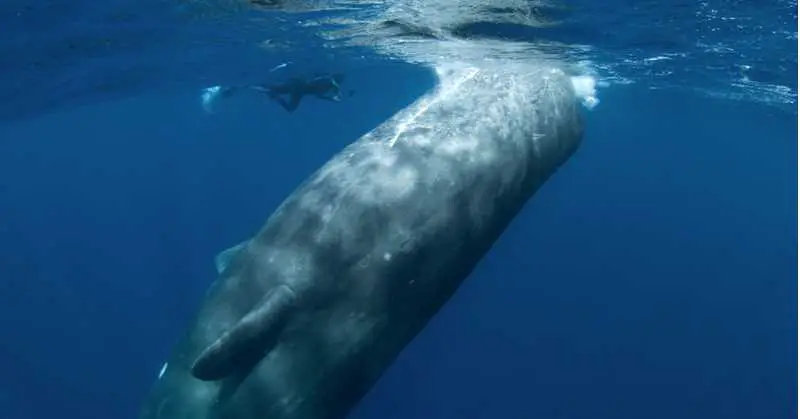
Imagine swimming in the open ocean with the world’s largest predator without the aid of any scuba breathing equipment. This is what a dedicated group of citizen scientists is doing as they try to understand how sperm whales communicate. Writer James Nestor joined them and shares some amazing video of sperm whales during a welcoming visit with humans.
Nestor became fascinated with the sport of freediving when Outside magazine sent him to Greece to cover the World Freediving Championships.1 That’s a form of diving that uses no breathing equipment, just going as deep in the ocean as you can on a single breath of air. Currently, Guinness pegs the world record holder as Herbert Nitsch of Austria who went down 214 meters (702 feet).2
After Nestor witnessed a diver stay underwater for 4 minutes, he was hooked. The interest brought him in contact with a group of citizen scientists who apply their freediving skills to studying sperm whales. He describes them as a group of “DIY renegade researchers” who “slapped-together gear and shoestring budgets [and] clocked more hours with the inhabitants of the ocean’s depths than anyone before them.”3
While many university researchers use robots and underwater cameras to study these giant whales, Nestor credited the words of one freediver to explain why he immersed himself with these mammals that can weigh up to 45 tons4: “Jane Goodall didn’t study apes from a plane…and so you can’t expect to study the ocean and its animals from a classroom. You’ve got to get in there. You’ve got to get wet.” 3
In the presentation linked below, Nestor details that the sperm whale is the loudest animal on earth, saying “They can hear each other in the ocean from hundreds even thousands of miles away. Some researchers believe that they’re able to keep in contact with one another through these clicks on other sides of the planet.”1
Incredibly, Nestor shares that the “clicks are so powerful in the water that they can blow out your eardrums easily. And they could actually vibrate a human body to death.”1 It has long been recognized that sperm whales use clicks for echolocation. Known as the world’s largest predator, sperm whales have been found to use this “biosonar” to track squids as much as a kilometer away. 5
As Nestor explains, “Sperm whales and dolphins also use clicks for communication. And inside of those clicks is probably one of the most sophisticated forms of communication we’ve discovered on the planet. Could be more sophisticated than human language.”1 A team from the University of Southern Denmark has been recording and analyzing interactions among sperm whales and, so far, has been able to identify almost two dozen recurring vocalized messages among groups of whales. They liken it to a form of Morse code.5
Freedivers have a huge advantage over traditional scuba divers when it comes to spending time in the water with sperm whales. Nestor explains that sperm whales are “cool” with people snorkeling near the surface, “but they get really excited when you are able to dive down about 50 feet and interact with them down there. And that is when they really stick around.” 1 In contrast, the whales find that scuba equipment is loud and disruptive to their underwater world.
Freedivers have found the whales to be incredibly welcoming. According to Nestor (as seen in the photo below), “Sometimes they orient themselves vertically and do this very weird sort of New Age thing around you. As they’re clicking. It’s extremely intense.” 1
Nestor wrote a book about his experiences with the citizen scientists entitled, Deep: Freediving, Renegade Science, and What the Ocean Tells Us About Ourselves. You can watch Nestor’s entire presentation “Humanity and the Deep Ocean” plus audience Q&A at The Interval in San Francisco here. 1 It is part of a lecture series sponsored by The Long Now Foundation that has a goal of fostering long-term responsibility for the future of the world as opposed to what most people do, just thinking about the here and now.
References
1Nestor J. “Humanity and the Deep Ocean.” The Long Now Foundation. 7 October 2014. https://theinterval.org/salon-talks/02014/oct/07/humanity-and-deep-ocean
2Guinness World Records. Freediving – No limit (men). https://www.guinnessworldrecords.com/world-records/freediving-no-limit-(men)
3Nestor J. Deep: Freediving, Renegade Science, and What the Ocean Tells Us About Ourselves. Houghton Mifflin Harcourt Publishing Company: New York, 2014. https://www.amazon.com/Deep-Freediving-Renegade-Science-Ourselves/dp/0547985525
4National Geographic Animal Reference. Sperm Whale. https://www.nationalgeographic.com/animals/mammals/s/sperm-whale/
5Svennevig B. What Does the Sperm Whale Say?” News. University of Southern Denmark. 7 May 2016. https://www.sdu.dk/en/nyheder/nyhedsarkiv/nyheder/arkiv_2016/juli/hvad_siger_kaskelothvalen

This Site Was Inspired By An Interest in Protecting the Environment:
We had the privilege and joy of learning from Dr. Charlie Stine who instilled a love for the natural world through incredible field trips with the Johns Hopkins Odyssey Certificate program in Environmental Studies. At the time, the program was endorsed by the Maryland Department of Natural Resources. Sadly, after Dr. Stine retired, the program was phased out. We hope that we honor his legacy by shining a bright light on environmental issues and sharing good news about the success of various conservation programs when possible.

